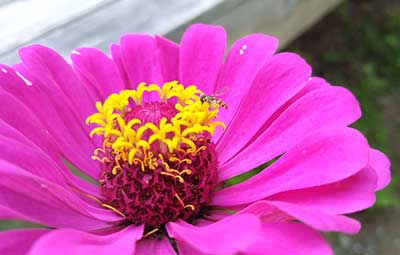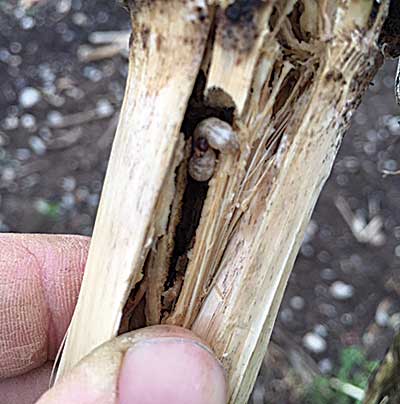European Corn Borer In Peppers (Among Others)
Winter Squash Looks Ready; Should I Harvest?
Farmers and gardeners are truly seeing the fruits of their labors now, with all manner of crops being harvested! As the harvesting season continues and you start to get the harvesting itch while looking at your winter squash, make sure it’s truly ready for peak flavor.
Progression of cucurbit downy mildew up the East Coast has been slow, so hopefully weather patterns will stay in our favor – though it recently reached Rhode Island (butternut squash), Long Island, New York (pumpkin), and Orange county, New York (cucumber). Similarly, New England has been free of any reported late blight, though several new cases have been reported on tomatoes in a few different counties in Pennsylvania, just this week.
Days are shortening and that means that nights are getting longer and reaching cooler temperatures. While that’s a relief in a lot of ways, that can also mean more overnight dew and longer periods of leaf wetness, which puts crops at greater risk of foliar infections like mildews and late blight.
 |
| Beneficial syrphid fly on zinnia flower |
This part of the season also brings with it the population buildup of beneficial insects that feed on crop pests! UMass Extension’s latest edition of their VegNotes newsletter has a great section on identifying some of the most helpful wild beneficial insects (pdf file). A highlight for me was learning that spined soldier bugs feed on Colorado potato beetles, and European corn borers which can start to be a problem in peppers this time of the year.
Thanks to all who responded to the previous pest report with your own reports of multiple scaped garlic. It seems that the same issue occurred in at least a dozen gardens and farms this year. (At the very least it’s nice for people to know they aren’t alone in their growing season oddities!) People reported between 5% and 50% of their garlic being affected, and sometimes the problem being restricted to one variety, though different people were reporting the issue with different varieties. Garlic was certainly one of the many overwintering crops that were negatively affected this past winter and spring, and some folks saw crop losses in wet, cold sections of their fields/gardens. Crystal Stewart from Cornell Extension has done a lot of work with garlic and confirmed that she’s seen this same scaping issue pop up before, both from aster yellows, or as we’re thinking is the case for the occurrence this year here in Maine: “…damage from freezing and thawing at the clove level, which seems to cause a variety of strange growth issues. If it’s that, the garlic will be genetically fine. We rarely see any additional issues the next year.”
 |
| European corn borer larva overwintering in corn stalk |
EUROPEAN CORN BORER IN PEPPERS (AMONG OTHERS)
Despite the name, European corn borer (Ostrinia nubilalis) can be found in over 200 different crop and weed plants, not just corn. Other crops that they can be found in include peppers, beans, potatoes, hemp, mums and sometimes even tomatoes. A few other caterpillar pests of sweet corn will also get into some of these same crops – for example, I found some fall armyworm in sweet peppers in the autumn of 2018, and ‘corn earworm’ has also earned itself the name ‘tomato fruitworm’ (and ‘cotton bollworm’). We’ll focus on peppers here, though the information is transferable to other crops as well.
European corn borer overwinter as larvae in crop debris, emerging as adults in the spring. Those adults fly, mate, and typically lay egg masses in early corn at 450 growing degree days (typically June in Maine). The following first generation of the year can then begin flying themselves as adults around 1400 growing degree days, and laying eggs around 1450 growing degree days (Central Maine has just recently exceeded this growing degree day point, so first generation European corn borer are potentially laying egg masses now). This second egg laying of the season is largely the one that can cause trouble in peppers and other non-corn crops.
Damage in peppers can be difficult to notice at first as the caterpillar only makes a small entry hole near the stem. The most obvious sign of an entry point is the small pile of frass that is left behind. Apart from potentially picking peppers with caterpillars inside them, the real damage occurs when soft rot bacteria and water make their way into the pepper through the hole that the caterpillar bored into the top.
European corn borer is a minor, or even non-existent pest of peppers for many, but where populations build up, and produce two generations, it can cause significant losses. If it has been an issue for you previously, consider pheromone traps to monitor for egg-laying flights of the adults.
An important cultural control is to remove or plow under crop debris that contains overwintering larvae. Insects that prey on European corn borer eggs and/or larvae include Trichogramma wasp species, and twelve spotted ladybeetles. If monitoring of adult moths shows sufficient pressure, effective spray options include Bt and Spinosad products.
Source materials, and more information can be found here:
- https://ag.umass.edu/vegetable/fact-sheets/european-corn-borer
- https://www.omafra.gov.on.ca/IPM/english/peppers/insects/eurpean-corn-borer.html#advanced
and monitoring and bio-control information is discussed further here:
WINTER SQUASH LOOKS READY, SHOULD I HARVEST?
By Eric Sideman
Winter squash look ready to harvest before they actually are mature. It is important to wait for maturity to have maximum storage and best eating quality. Most squash varieties reach full size by 20 days after fruit set. Accumulation of starch and other dry matter peaks at about 30-35 days after fruit set. But, the fruit is not fully mature until the seeds are fully developed, which occurs about 55 days for butternut. This is different for other varieties. If you would like to read more, take a look at this article by Brent Loy, the very well known plant breeder at the University of New Hampshire. Or, here is a summary put together by the folks at Johnny’s Selected Seeds.
Harvest and Storage
A critical factor in eating quality is maturity of the squash when it is harvested. Most small varieties reach full size by 20 days after fruit set. Accumulation of dry matter and starch content peaks at 30 to 35 days after pollination. However, the fruit is not mature until the seeds are fully developed, which occurs about 55 days after fruit set.
Dr. Loy stresses the importance of maintaining healthy plants until at least 50 days after fruit set because photosynthesis is essential to the development of sugars and dry matter. A squash that is picked too early will continue to develop seeds, but it does so by depleting the dry matter, thereby reducing eating quality.
Although fruit and seed maturity are similar across the three main species of edible winter squashes and pumpkins, harvest and storage recommendations vary by type.
Cucurbita maxima | Kabocha, Hubbard, and Buttercup Squashes
Kabocha, hubbard, and buttercup (C. maxima) varieties should be harvested before complete seed maturation, at about 40 to 45 days after fruit set, when the fruit is still bright. That’s when the rind is hardest, so less likely to be damaged in storage. They also are susceptible to sunburn as the vines die down, so it’s best to get them harvested and out of direct sun before then to prevent the rind from turning brown or, with extreme sunburn, white. Kabocha squash have a high dry matter content and small seed cavity, so seed maturation off the vine is not a problem. However, once harvested, they should be stored at room temperature for 10 to 20 days to allow sugars to reach acceptable levels.
C. pepo | Acorn Squash, most Pie Pumpkins
Acorn squash (C. pepo) are misleading because they reach full size and develop a dark green-to-black mature color about two weeks after fruit set – 40 to 50 days before they should be harvested. Dr. Loy says that a better way to judge maturity is to look at the rind where it touches the ground. Immature squash have a light green or light yellow ground color, whereas mature squash have a dark orange ground color. Immature acorn squash have low sugar levels and although they will develop sweetness after harvest, they do so by depleting the dry starchy matter to convert it to sugars. This means storage life is shortened and eating quality declines.
C. moschata | Butternut Squash, some Pie Pumpkins
Butternut squash (C. moschata) are easier to judge by sight because they don’t acquire their characteristic tan color until late in development, 35 days or more after fruit set. If the weather stays frost-free, they should be allowed to remain on the plants until 55 days after fruit set. In short-season areas, they often are harvested soon after turning tan because of the risk of frost damage. At that point, however, the sugars have not elevated to the 11% required for good flavor, so butternut squash harvested at 55 days after fruit set should be stored for 60 days at 56-60°F/10-16°C, with relative humidity between 50 and 70%. Carotenoid content also increases in storage, making the butternut squash more nutritious after it’s been stored for a couple of months. To accelerate maturity and increase sweetness, Dr. Loy has found that butternuts held at warm temperatures (up to 85°F/29°C) for two weeks develop acceptable levels of sugars.

This material is based upon work supported by the National Institute of Food and Agriculture, U.S. Department of Agriculture, through the Northeast Sustainable Agriculture Research and Education program under subaward number ONE19-334.
Any opinions, findings, conclusions, or recommendations expressed in this publication are those of the author(s) and do not necessarily reflect the view of the U.S. Department of Agriculture.
